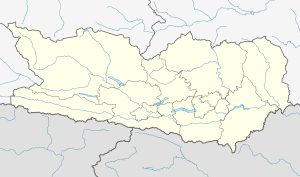Hollenburg Bridge
Coordinates: 46 ° 32 '36 " N , 14 ° 15' 42" E
| Hollenburg Bridge | ||
|---|---|---|
| Convicted |
|
|
| Crossing of | Ferlach Reservoir ( Drau ) | |
| Subjugated | Rosentalbahn , Drauradweg | |
| place | Köttmannsdorf , near Ferlach | |
| construction | Prestressed concrete - box girder bridge | |
| overall length | 668.5 m | |
| width | 22.5 m | |
| completion | 1974 | |
| location | ||
|
|
||
The Hollenburger Brücke crosses the Ferlach reservoir , which damms the Drau here , on the Loiblpass road in Carinthia . Predecessor buildings that made it possible to cross the Drau had existed at least since the High Middle Ages .
The bridge is named after Hollenburg Castle , which once dominated the Rosental valley directly above it on the rocky southern slope of the Sattnitz .
Below is the Rosentalbahn , which crosses the Ferlach reservoir on a steel truss bridge below the castle . The Drau Cycle Path runs on the dike on the opposite side .
description
The 668 m long and 22.5 m wide four-lane bridge runs in a large curve over the Ferlach reservoir. Its 3.5% north-south gradient ends in a trough radius in front of the southern bank.
It consists of two closely juxtaposed prestressed - box girder bridges , each with a 9 m wide carriageway and a 1.25 m wide flange on the eastern or a 2.20 m wide walkway on the west side.
It was planned and built together with the Ferlach reservoir and opened to traffic in 1974. It is one of the largest bridges in Carinthia and is passed by around 10,000 vehicles every day.
history
It is not known when the first Hollenburg bridge was built. It is possible that the Lords of Hollenburg had a wooden bridge built when the Viktring Monastery, newly founded by Count Bernhard von Kärnten , began building a hospice on the Loibl Pass .
It was mentioned in a document for the first time between 1220 and 1224, when Swiker von Hollenburg , his mother Adeled and his uncle Otto von Steierberg bequeathed the bridge to the Viktring monastery in order to take care of the salvation of his father Amelrich, who lived overseas , i.e. probably on the fifth, the Crusade of Damiette , died. For this, the monastery had to grant everyone free passage. For obtaining the bridge it received the Sechterwald above Ferlach and strokes in Weizelsdorf . In another document, Duke Bernhard of Carinthia confirmed the transfer of the bridge to the monastery and gave him a hatch in Glainach for repair .
The maintenance of the bridge was the subject of numerous disputes between the lords of the castle and the monastery in the next 300 years, which finally returned the bridge and the donation to the Hollenburg rulership in 1550, which had meanwhile passed to the Dietrichsteiners . They then enlarged this to a bridge with 12 yokes , which could not only be used by pedestrians and pack horses , but now also by carts . Archduke Max , the governor of Carinthia at the time, granted them the first bridge toll in 1595 .
The Hollenburg Bridge was damaged or destroyed in several armed conflicts, such as the Turkish invasion of 1480 and the reconquest of Carinthia, which was conquered by Napoleon Bonaparte , by the Austrians, who crossed the Drau on September 19, 1813 on a pontoon bridge next to the ruins of the bridge . She was repeatedly torn away by the floods of the Drau, z. B. by the Magdalen flood in 1342 or, more recently, by the flood of the century in 1851. Most recently, the wooden bridge modernized for traffic over the Loiblpass was torn away by the floods of August / September 1965.
A temporary bridge built by the pioneers of the armed forces did its job until the Ferlach-Maria Rain power plant was built between 1971 and 1975 and the Ferlach reservoir was built when the Hollenburg bridge had to be rebuilt at a higher elevation.
Web links
Individual evidence
- ^ Draubrücke Hollenburg . In: Bridge construction in Carinthia , Office of the Carinthian Provincial Government, Department 9 - Roads and Bridges, p. 42 (PDF; 13.7 MB)
- ^ August von Jaksch: The Carinthian historical sources . Fourth volume 1202–1269, first part 1202–1262. Ferd. v. Kleinhalter, Klagenfurt 1906, p. 109, 110 ( limited preview in Google Book search).
- ↑ Kärntner Landesarchiv general document series AT-KLA 418-BA 1528 St (MC IV / 1, 1809: dat. (1220-1224)) on: monasterium.net
- ↑ The Piermann-Hube in Weizelsdorf on members.yline.com
- ↑ Carinthian Provincial Archives General series of documents AT-KLA 418-BA 1529 St (MC IV / 1, 1810: dated (1220-1224)) on: monasterium.net
- ↑ JS Ed. JG Gruber (Ed.): General Encyclopedia of Sciences and Arts . Volume 2, Second Section H – NFA Brockhaus, Leipzig 1833, p. 63 ( full text in Google Book Search).
- ↑ Carinthia flood chronicle at ktn.gv.at
- ^ The disaster years 1965/66, article from September 2, 2015 on kaernten.orf.at
- ↑ Ferlach-Maria Rain run-of-river power plant on verbund.com


